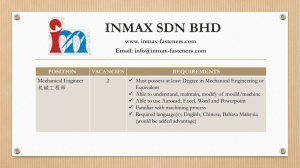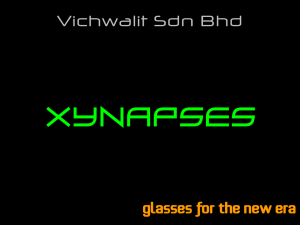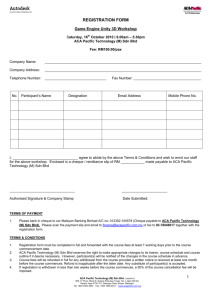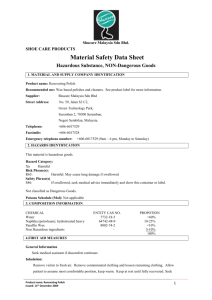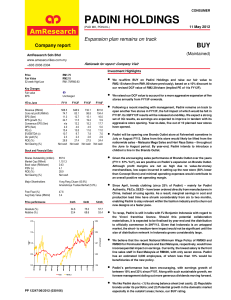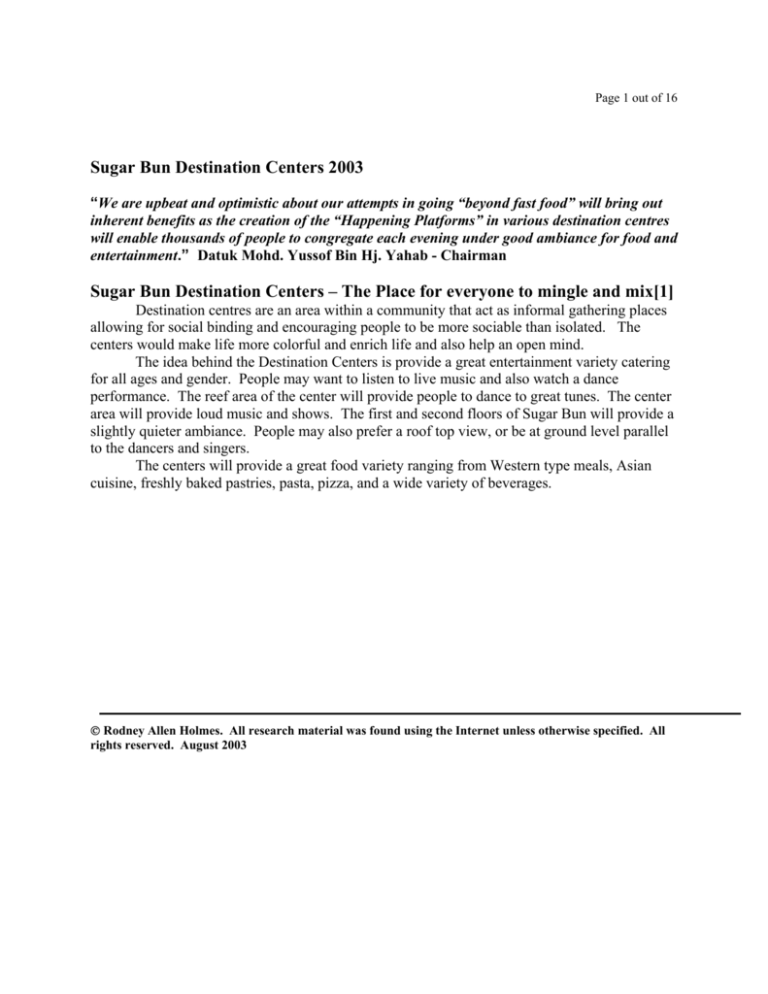
Page 1 out of 16
Sugar Bun Destination Centers 2003
“We are upbeat and optimistic about our attempts in going “beyond fast food” will bring out
inherent benefits as the creation of the “Happening Platforms” in various destination centres
will enable thousands of people to congregate each evening under good ambiance for food and
entertainment.” Datuk Mohd. Yussof Bin Hj. Yahab - Chairman
Sugar Bun Destination Centers – The Place for everyone to mingle and mix[1]
Destination centres are an area within a community that act as informal gathering places
allowing for social binding and encouraging people to be more sociable than isolated. The
centers would make life more colorful and enrich life and also help an open mind.
The idea behind the Destination Centers is provide a great entertainment variety catering
for all ages and gender. People may want to listen to live music and also watch a dance
performance. The reef area of the center will provide people to dance to great tunes. The center
area will provide loud music and shows. The first and second floors of Sugar Bun will provide a
slightly quieter ambiance. People may also prefer a roof top view, or be at ground level parallel
to the dancers and singers.
The centers will provide a great food variety ranging from Western type meals, Asian
cuisine, freshly baked pastries, pasta, pizza, and a wide variety of beverages.
© Rodney Allen Holmes. All research material was found using the Internet unless otherwise specified. All
rights reserved. August 2003
Page 2 out of 16
Background
The company has assumed different names through the past several decades. On
November 26, 1990 it changed its name from WK Wung Holdings Sdn Bhd to Motherwell
Corporation Sdn Bhd. On September 16, 1991 it changed its name to Sugar Bun Services
Corporation Sdn Bhd. Finally on June 24, 2002 it changed its name to Sugar Bun Corporation
Bhd. The stock is traded on the Second Board of the KLSE.
The Group's principal activities are the operation and franchising of restaurants, bakeries
and confectioneries. Other activities include provision for food processing, general trading and
catering services, manufactures and sells ice cream, food and beverages, provides administrative,
marketing and management services, and trades equipment and spare parts.
Upstream Value Chain Activities
The group imports all its beef and fish fillets requirements from Australia and New
Zealand. Chicken requirements are sourced from local suppliers. The company processes the
meat locally.
Downstream Value Chain Activities
The company is organised into two major business segments: restaurant and franchising
operations; and general trading of machinery and spare parts and phone cards. During the past
year the restaurant and franchising segment generated RM42,810,824 in sales, while the general
trading of machinery and spare parts generated RM5,587,151 in sales. (See Appendix A) The
following table lists the subsidiaries of the company.
Name of Group Subsidiaries
Sugar Bun Fast Food Centre Sdn.
Bhd.
Equity
Interest
100
Principal Activities
Fast Food Restaurants and investment
holding
Subsidiary:
Strawberry Foods Sdn. Bhd.(Fast food
Restaurants)
Subsidiary:
Strawberry Baking System Sdn.
Bhd.(Bakery and Confectionery)
Applebee’s Bakery Sdn. Bhd.
100
Vanilla Foods Centre Sdn. Bhd.
100
Vanilla Enterprises Sdn. Bhd.
100
Bakery, confectionery and investment
holding
Food processing, general trading and
provision of catering services
General trading and providing management
and marketing services
Page 3 out of 16
Grand Colada Sdn. Bhd. And
Landrock Realty Sdn. Bhd.
L & V Trading Sdn. Bhd.
SB Resorts Sdn. Bhd.
100
Property Holding
100
100
Softmatics Sdn. Bhd.
100
Equipment and spare parts trading
Provision of management services, catering
services, and café cum entertainment
operation
Investment holding, manufacturer and sale
of ice cream.
Subsidiaries:
Labuan Fast Food Centre Sdn.
Bhd.(Investment Holding)
Caprila Sdn. Bhd. (Sales of ice cream,
food and beverages)
Source: Annual Report 2003 pp.45-46.
Restaurant and Franchising Segment
The Group has the following brand names under its umbrella: SugarBun, AppleBee's and Caprila
Ice Cream.
Sugar Bun Restaurants
In 1978, SugarBun began as an ice cream and snack parlour in a little corner next to
Kenyalang Theatre in Kuching, Sarawak. In 1981, a fast food restaurant was added with SB
Chicken as its hero product.
SugarBun has evolved into a diversified and franchising group with more than 50
restaurants spread across Malaysia, Negara Brunei Darussalam and China.
`
Sugar Bun’s exacting standards has earned it the coveted MS ISO 9002 award for
'Quality Excellence in Preparation and Sale of Food' by the Standard & Industrial Research
Institution of Malaysia (SIRIM.
One of SugarBun’s success factors is its proven and customer-tested menu including its
signature entries - SB Chicken and savoury rice. Sugar Bun has refined its menu through
intensive Research & Development efforts by blending Asian culinary tastes with safe, hygienic
and modern equipment and techniques. Regionally, it is an acknowledged leader in the fast food
business offering consistency in high quality, healthy and delicious meals in clean, cozy and
friendly restaurants.[2]
Sugar Bun has a recognizable brand name with a distinctive trademark and signage.
Sugar Bun utilizes an on-going stream of creative and successful advertising and costeffective marketing programs for new product introductions, promotions and point-of-sale
materials.
Sugar Bun has recently introduced a new “lifestyle” branding concept to its outlets.
“Business at some outlets have increased by between 100% and 300%, depending on the
location,” Sugar Bun Corp Bhd regional general manager for Sarawak, Johnny Leo Lee Boon,
said. Leo said that under the new concept, the number of food items offered at a Sugar Bun
restaurant was increased.[3]
Applebee’s Bakery Sdn. Bhd.
AppleBee’s is sold in the regular Sugar Bun restauruants, and brand name bakeries.
.
Page 4 out of 16
Caprila Ice Cream.
Caprila Ice Cream is sold in the regular Sugar Bun restaurant, and in some centers there
are Caprila Ice Cream Cafes.
Malaysian Food Serice Industry[4]
Type of Establishment
Full Service Family Restauraunts
Food and Drinks Hawker stalls
Fast Food Restaurant Chains
Coffee Shops
Hotels and Resorts
Catering Services
Market Share(Percent)
25
25
15
15
15
5
Hawkers
Hawkers are the backbone of the Malaysian food industry. The hawkers provide a limited
range of local dishes at inexpensive prices, and command around 25% of the total food service
market. These businesses operate from temporary roadside stalls, coffee shops, and food halls in
modern shopping complexes. This sector’s market segment consists of low to middle income
workers, families and students.
Full Service Family Style Restaurants
Full service family style restaurants are usually air-conditioned, and provide waiter
services. The restaurants have around 25% of the total food service market. The restaurants
provide different cuisine such as Asian, European, and American. This sector’s market segment
consists of middle to high-income groups, business people, tourists and affluent younger
Malaysians.
Local Coffee Shops
Local coffee shops offer simple local dishes for breakfast and lunch at inexpensive prices,
without air conditioning and waiter services. The coffee shops have around 15% share of the
total food service market. The coffee shops cater mainly to low and middle income consumers.
Quick Service Restaurants
The QSR sector consists of both international and local fast food companies. This sector
has around 15% of the total food service market.
Competition is intense. Seventy percent of customers who patronize quick service
restaurants are students in the "teen" market. Some 36 percent of its 23 million population are
aged 15 years and below, and this points to a potentially large consumer base for the fast-food
business.[5]
Hotels and Resorts
Hotels and resorts have around 15% of the total food service market.
The three to five star rated hotels operate restaurants that are key users of imported food
and beverages. Usually each hotel has more than three food and beverage outlets: a coffee
Page 5 out of 16
house; a local Asian restaurant; a foreign restaurant (Western food or Japanese food); and a bar
that is licensed to sell alcoholic drinks.
Franchising in Malaysia
Malaysia has enacted comprehensive regulations that govern all aspects of franchising,
including disclosure, registration, and the relationship itself. Under the Malaysian law, franchise
agreements must be in writing, must have a term of at least five years, and must have a coolingoff period of at least seven working days.[6]
The Malaysian Franchise Association was formed in 1994 to support the implementation
of the Government program to promote entrepreneurship through franchising. The objectives of
the association was to: to unite the members in view of protecting their interests; to cultivate and
protect the image of franchising and encourage ethical business practice; and to support the
government’s effort in encouraging Bumiputra’s direct and active involvement in franchising.
The functions of the association are extensive. Some of the most important functions are:
Set and enforce standards of ethical business amongst members; act as a registry for information
pertaining to franchise business operating or intending to operate within the country; coordinate
and offer educational programs, seminars and exhibitions specially oriented to franchising
matter; undertake promotional activities to promote franchising as a successful marketing
business concept; provide input and liaise with government departments and / or agencies on
matters concerning franchising and its application; and establish and maintain affiliations with
counterpart organization globally.[7]
The following table shows the capital investment needed to obtain a franchise in
Malaysia for a quick service restaurant.[8]
Company
McDonald's
Dave’s Deli
Marry-Brown Family Restaurant
Sugarbun
Chicken King
Kenny Rogers Roasters
Capital Investment
RM1.2-RM1.5 million
RM200,000-500,000
RM150,000-RM2 million
RM120,000-450,000
RM18,000-RM380,000
RM450,000 - RM650,000
Environmental Factors
Opportunities
Purchasing Power
The middle to upper income group comprises sixty-one percent of Malaysia’s population.
. The population is well educated and is growing at more than 2% per annum.[9]
Population Demographics
Malaysian’s percentage age levels are given below:
0-14 years: 35%,
15-64 years: 61%,
65 years and over: 4%
Page 6 out of 16
More than 36% of the population is under 15 years of age. The majority of them are
expected to participate in tomorrow’s consumer market.[10]
Increasing Number of Shopping Malls
New modern air-conditioned shopping malls are continuing to open, providing increased
opportunities for food service operators to access customers on a nationwide basis. The most
successful food service businesses have strategies that involve obtaining prime sites within the
country’s key shopping malls/areas. This also involves new food service outlets along
Malaysia’s highways, in particular the North-South highway.
Increased usage of new shopping malls has resulted in increased usage of the modern
food service outlets operating within the malls.
Changing Dining Out Patterns
Diet and eating/dining-out habit modernization especially amongst Malaysia’s more
affluent and younger urban residents is underpinning demand for a broad range of food service
outlets.
Menu Diversification
Menu diversification by food service operators is part of their strategy to attract younger
urban residents to their outlets.
Buyer Preferences
Many of Malaysia’s food service buyers are well exposed to foreign products and
understand product quality based on their comparisons with equivalent products.
Halal Certification
Halal certification is a total quality health and sanitary system that involves adopting
procedures for slaughtering, processing and other related operations as prescribed by Islamic
rules. It certifies raw materials, ingredients and products based on quality, sanitary and safety
considerations.[11]
Malaysia aims to be the international center for halal food production and its
accreditation on halal products is highly respected and recognized by most Islamic nations.
Constraints
Sourcing of orders for the food service sector
Relatively small and frequent order quantities by the food service sector mean that buyers
are unable to source directly from exporters who prefer to satisfy large orders only.
Page 7 out of 16
Malaysian Food Culture
Malaysian food culture is strong and dominates restaurant output, which mainly revolves
around local Malay, Chinese and Indian dishes today.
Suppliers of food and beverage
Local products and those from neighboring countries dominate the supply of food and
beverages to Malaysia’s food service sector. This includes supplies to fast food businesses like
McDonald’s and KFC, which have localized/ASEANised many of their food and beverage
requirements.
Price Sensitivity of Consumers
Price sensitivity of consumers affects the food service sector’s buyers and their suppliers,
e.g. importers and distributors.
Distribution Network
Malaysia’s large geographical area requires a strong distribution network to supply all
urban areas where key food service outlets operate. Increased spending in the food service sector,
especially in the urban areas.
Limited Number of Distributors
Limited availability of importers/distributors for imported products targeting food service
users.
Trends in the UK Quick Service Restaurant(QSR) Industry[12]
The QSR industry in the UK is in the mature stage of the product life cycle. To remain
the market leader, for a company like McDonald’s, involves enhancing the reputation of the
brand coupled with product innovation based on detailed market research.
In the past, the success of McDonald’s was due to a formula of providing a range of
standardized products quickly and cheaply. However, through their research, the company has
discovered that modern consumers of all ages are seeking experiences that are more
individualized than in the past.
The QSR industry in the UK is very competitive. Many of McDonald’s competitors had
copied the trail blazing ideas of the company, and had promoted new ideas of their own such as
making fast food available in urban supermarkets and petrol stations. McDonalds has had to
develop competitive strategies that differentiated it from its rivals. The company has
differentiated its product in three ways: adding greater value through innovation; making the
process of visiting a McDonald’s less routine and controlled; and enhancing the overall in-house
experience.
The company’s market research indicates there are a number of trends apparent in the
industry. Snacking is important among teenagers and young people. The importance of organic
food is rising. Chicken continues to be seen as healthier than red meat. The traditional
mealtimes of breakfast and lunch are becoming less important, and the main meal of the day has
to be flexible to reflect the changing lifestyles of consumers.
Page 8 out of 16
The company has adapted its marketing mix to reflect these realities.
It provides the right product. The menu contains chicken as well as beef, salad items,
and healthy drinks for children.
It charges the right price. The menu offers a flexible combination of drinks, sandwiches,
etc. in addition to a basic meal to provide value for money.
It provides it product in the right place such as shopping areas/malls.
It provides the right promotion to promote its products.
Quick Service Restaurant (QSR) Industry in Malaysia
The Quick Service Restaurant (QSR) industry is dynamic, highly competitive and vulnerable to
adverse developments in the economy. The following table shows the approximate market share
of the main competitors in the industry.
Company
KFC Holdings (Malaysia) Bhd’s
McDonald’s
Marry Brown
Sugar Bun
Other
Market Share - Percent
60
20
6.7
2.5
10.8
Source: Various
The preceding table indicates that KFC Holdings has the greatest market share in
Malaysia.
KFC Holdings (Malaysia) Bhd’s - KFCH
The company is the franchise holder of KFC for Malaysia, Brunei and Singapore and
Pizza Hut for Malaysia and Singapore. As of April 2003, the company has 327 KFC and 102
Pizza Hut outlets in the country.
KFCH’s solid footing in the local market is attributable to its strategies of backward
integration(feedmill, breeder farms, hatchery, contract broiler farms, poultry processing plant,
sauce manufacturing plant, bakery, and bottling plant) and successful expansion in both urban
and rural areas ahead of its competitors.
The wide restaurant network built over the years has generated the critical mass in
customer traffic necessary for the Group to maintain its dominant market position.
The Group also consistently introduces new products, developed by the franchisors and its inhouse research & development unit, to respond to changing consumer tastes over time.[13]
McDonalds
Golden Arches Restaurants Sdn. Bhd. was incorporated in Malaysia in December 1980. It
has the license to operate McDonalds restaurants in Malaysia by the McDonalds Corporation,
U.S.A. They opened their first McDonalds restaurant at Jalan Bukit Bintang, Kuala Lumpur, in
April, 1982.
Page 9 out of 16
To date, Malaysia has 146 restaurants nationwide that serve over 5 million customers
monthly. [14]
The company plans to double sales in four years, leveraging on its just launched threeyear “i'm lovin' it” campaign.[15]
Marry Brown
The Marrybrown chain of family restaurants, currently the 3rd largest fast food chain in
Malaysia after KFC and McDonald’s, has already made inroads into Brunei, India, China and
Dubai, and is currently negotiating for the opening of outlets in Indonesia and Thailand. It is also
eyeing other markets such as Myanmar, South Africa and the Philippines.
The eatery, serving primarily burgers, both vegetable and non vegetable, and fried
chicken along with side dishes, providing great value for the money, and is affordable to
students, couples, and families.
The company’s aim is to establish Marrybrown as a global fast food chain that could one
day introduce Malaysian signature food like satay to the rest of the world. [16]
Dave’s Deli
Dave's Deli is a medium-meal-price quick service restaurant requiring high sales turnover
as well as tight control of labor and food costing.
Dave's Deli differentiates itself from competitors by offering a more extensive menu. By
featuring a more diversified menu, Dave's Deli has increased its appeal to a wider and greater
spectrum of eating times, consumer tastes and market segments. delights. We provide a special
weekend roast, which may vary, from prime US beef to NZ lamb.[17]
Page 10 out of 16
Financial Highlights
Profit and Loss Summary
During the past year sales increased by 29%. However, the cost of sales increased by
39%, and the administrative expenses increased by approximately 19%. The loss position
improved by RM1,057,650.[18]
Consolidated Income Statement as of January 31, 2003
Revenue
Cost of Sales
Gross Profit
Other Operating Income
Administrative and other operating expenses
Loss from Operations
Finance cost, net
Loss before taxation
Taxation
Loss after taxation
Minority interests
Net Loss for the year
2003(RM)
2002(RM)
48,397,975
25,740,610
22,657,365
2,560,231
30,859,709
5,642,113
834,449
6,476,562
466,996
6,009,566
92,957
5,916,609
37,532,627
19,251,496
18,281,132
330,359
26,012,170
7,400,679
587,638
7,988,317
917,267
7,071,050
96,791
6,974,259
Working Capital Requirements
During the year the working capital position of the company improved dramatically. In
2002 the working capital position of the company was –RM1,865,477.00. The working capital
position of the company in 2003 was RM27,186,259.00.
Consolidated Balance Sheet as of January 31, 2003.
NON-CURRENT ASSETS
Property, plant and equipment
Other investments
Long term receivables
Intangible assets
CURRENT ASSETS
Inventories
Trade receivables
Other receivables
Cash and bank balance
2003(RM)
2202(RM)
40,446,893
5,530
2,603,832
4,079,692
47,135,947
30,845,712
5,530
5,231,829
5,147,362
41,230,433
5,118,142
4,422,208
21,205,839
10,001,810
3,954,305
4,049,422
5,046,466
3,977,527
Page 11 out of 16
CURRENT LIABILITIES
Short term borrowings
Trade payable
Other payables
Taxation
NET CURRENT ASSETS(LIABILITIES)
FINANCED BY:
Share Capital
Reserves
Shareholders’ equity
Minority interests
40,747,999
2003(RM)
17,027,720
2002(RM)
2,254,944
9,304,839
1,824,693
177,264
13,561,740
7,096,648
10,150,050
1,454,802
191,697
18,893,197
27,186,259
74,322,206
(1,865,477)
39,364,956
68,640,000
326,095
69,431,635
465,540
69,431,635
27,456,000
9,640,270
37,654,767
558,497
37,654,767
4,874,571
16,000
4,890,571
1,228,189
482,000
1,710,189
74,322,206
39,364,956
Long term borrowings
Deferred taxation
Corporate Governance – Annual report 2003[19]
The board has four members. Two of the members are executive directors, and two are
non-executive directors. The non executive directors are independent.
The roles of chairman and executive director are separated to ensure the balance of power
and authority. The non executive directors provide the board with a mix of skill and experience.
The chairman of the board is Datuk Mohammed Yussof Bin Haji Yakob.
Datuk Mohammed Yussof Bin Haji Yakob – (Independent Non-Executive Chairman) -54
Datuk Mohammed Yussof Bin Haji Yakob was appointed a Director of SSCB on 23rd
March, 2001 and was appointed chairman of the company on 23rd August, 2001.
He formerly served with the State Government of Sabah. From 1975 to 1977 he held the
Registrar of Land position. From 1978 to 1980 he was appointed as Permanent Secretary of the
Sabah State Ministry of Manpower and Environmental Development.From 1981 until March
1982 he was appointed as Permanent Secretary of the Sabah State Ministry of Communication
and Works. He held various other posts such as Deputy Chairman of Sabah Tourism Promotion
Page 12 out of 16
Corporation(1978 until 1980), Deputy Chairman of Sabah National Parks (from 1984 until
1986), Deputy Chairman of Sabah Credit Corporation (1984 until 1986), Vice Chairman of
Migration Fund Board Sabah (1978 until 1980) and from 1981 until
1992 as Board Member of Sabah Ports Authority and Sabah Electricity Board. He
held professional qualifications in LLB (Adelaide) and CLP (Malaya),. He currently
is an advocate and solicitor.
Datin Kong Hwa Ling (Executive Director) - 46
She was appointed to the board on August 23, 2001.
Since 1984, she had been formerly appointed a Director of Softmatics Sdn Bhd. The
company is now a subsidiary of SSCB.
She is the Property Manager for various Malaysian private limited companies involved
in property investment.
Tan Kok Chor (Independent Non-Executive Director) – 53
He was appointed to the board on August 21, 2001.
He has more than 5 years experience in litigation, conveyancing and preparing legal
documentation and related matters. He is also a very experienced businessman involved in
property investment.
He holds directorships in several other Malaysian private limited companies.
Chee Su Kyun (Executive Director)- 42
He was appointed to the board on July 3, 2002.
He leads a strong operations team consisting of operation, marketing, training and project
personnel.
He holds a Bachelor Degree in Finance, Business Administration and Economics. He
obtained his degree from the University of Western Ontario, Canada.
Prior to joining the company he was involved in 3 major international fast food franchise
namely KFC, Pizza Hut and Burger King for 12 years. His international exposure includes
United States of America, Australia, Hawaii, Korea and Singapore.
The Reef Project Dance Bar and Grill
A RM6million destination centre in Beach Street, Kota Kinabalu in Sabah, is drawing in
the crowds. The talk-of-the-town flagship outlet operating round the clock has under its roof a
SugarBun restaurant, western grills, a Japanese restaurant, a fun pub, a wine bar and a family
recreational area.
The centre's most distinctive feature is “The Reef Project Dance Bar and Grill,'' inspired
by Borneo's indigenous marine life.
Every major town in Sabah and Sarawak would eventually have a destination centre
covering at least 20,000 sq ft each., and two such centres have also been planned for Kuala
Lumpur.
The development of the destination centres forms a major effort by SugarBun to
reposition itself in an increasingly competitive fast food market.[20]
Page 13 out of 16
Appendix A Segment Information[21]
Revenue & Franchising
Operations(RM)
General Trading(RM)
2003
2002
2003
2002
Revenuea nd Expenses
External Sales
Iner-segment Sales
Total Revenue
42,810,824
37,561,712
42,810,824
37,516,712
5,587,151
874,608
6,461,759
Results
(5,687,913)
(7.090,104)
45,800
Segment Assets
85,830,144
57,006,473
2,053,802
1,251,680
Segment Liabilities
18,307,333
20,597,958
144,978
5,428
Capital Expenditure
14,996,564
1,569,166
2,698
23,573
Depreciation
3,172,285
3,069,756
8,068
6,821
Amorization of goodwill, intangible
Assets, and prepaid lease rental 1,141,038
1,067,670
15,915
741,924
757,639
(310,575)
Appendix B Share Capital Information [22]
Authorized(Par Value – RM1)
2003
2002
100,000,000
100,000,000
27,456,000
26,594,000
Issued and Fully paid
At Febraury 1
Issued under Employees Share
Option Scheme
Issued under the Rights Issue,
at par
At 31 January
862,000
41,184,000
68,640,000
N/A
27,456,000
Note: The Rights Issue was used to finance working capital requirements and expansion. The related costs
amounted to RM3,397,566. The new ordinary shares rank pari passu in all respects with existing ordinary shares.
Page 14 out of 16
Appendix C: Other Receivables(RM)[23]
2003
Prepaid Lease Rental(See Note 1)
Advances to Suppliers
Amount Due from Subsidiaries
Amount Due from Resort Company(See Note 2)
Amount Due from Local Franchisee
Amount Due from a Franchisee in China
Prepayments
Deposit
Sundry Receivables
Tax Recoverable
Less: Provision for Doubtful Debts
7,753,463
3,185,874
-4,599,000
11,518,965
-1,099,777
3,447,632
1,016,671
223,370
32,644,772
(11,638,933)
21,205,839
2002
-2,631,000
11,518,965
2,100,480
1,685,624
607,581
241,771
18,785,421
(13,738,955)
5,046,466
Notes:
1.
2.
The rental payments are costs incurred in developing certain areas in Kota Kinabalu belonging to the
government authority in return for allowing the Group to operate its operation in these areas for a period of
between ten to eleven years in lieu of rental payment.
In a prior year, a subsidiary, SB Resorts Sdn Bhd made certain advances to a resort company under a marketing
and management agreement. The amount is be paid via 36 monthly installments commencing February 1,
2002.
Page 15 out of 16
Appendix D: Consolidated Cash Flow Statement (RM)[24]
2003
2002
(6,476,562)
(7,988,317)
3,180,353
727,773
73,368
567,670
173,188
500,000
3,076,577
295,032
CASH FLOWS FROM OPERATING ACTIVITIES
Loss before taxation
Adjustments for:
Depreciation
Property, plant and equipment written off
Amortisation of prepaid lease rental
Amortisation of goodwill arising on consolidation
Loss on disposal of property, plant and equipment
Amortisation intangible assets
Provision for doubtful expenses
Write back of provision for doubtful debts
Interest Expense
Interest Income
Operating loss before working capital changes
Increase in inventories
Increase in receivables
(Decrease)increase in payables
Cash Used in Operations
Interest Paid
Taxes Refunded(paid)
Net Cash Use in oOperating Activities
(2,100,000)
1,003,075
(76,226)
(2,427,361)
(1,163,837)
(11,895,931)
(475,320)
(15,962,449)
(1,003,075)
4,964
(16,960,560)
625,676
(104,713)
(2,848,757)
(503,875)
(931,467)
3,624,123
(659,976)
(625,676)
(51,884)
(1,337,536)
CASH FLOWS FROM INVESTING ACTIVITIES
Purchase of Property, plant and equipment
Proceeds from disposal of property, plant and equipment
Interest Received
Net Used in Investing Activities
(14,421,962)
1,316,767
76,226
(13,028,969)
(1,553,685)
669,471
104,713
(749,501)
37,786,434
564
(256,366)
12,000,000
(8,311,973)
41,208,659
2,086,040
176,035
(229,051)
500,000
(171,336)
2,361,688
NET INCREASE IN CASH AND CASH EQUIVALENTS
11,219,130
274,651
CASH AND CASH EQUIVALENTS AT BEGINNING
AT BEGINNING OF FINANCIAL YEAR
(2,480,237)
(2,754,888)
CASH AND CASH EQUVALENTS AT END OF
FINANCIAL YEAR
8,738,893
(2,480,237)
CASH FLOWS FROM FINANCING ACTIVITIES
Proceeds from issuance of share, net of related expenses
Drawdown of banker acceptances and trust receipts
Repayment of hire purchases and lease financing
Drawdown of term loans
Repayment of term loans
567,670
161,522
500,000
17,796
Page 16 out of 16
References
1. Sugar Bun Destination Centres – Annual Report 2003
2. Sugar Bun Website URL: http://www.sugarbun.com/history.htm (August 2003)
3. Jack Wong(2003). ‘Sugar Bun volume up nearly three-fold’ URL:
http://biz.thestar.com.my/news/story.asp?file=/2003/8/8/business/6012971&sec=business
(August 2003)
4. Jacelyn Chang(2002). ‘Structure of the Industry(Malaysia Exporter Guide Annual 2002 –
USDA Gain Report’
5. Dawn Neo(2003). ‘Fast forward’. URL: http://www.apfoodonline.com/magazines/2003/janfeb/article/art03.htm (August 2003)
6. The Malaysian Franchise Act was given Royal Assent on December 24, 1998.
7. Malaysian Franchise Association. URL:
http://www.mfa.org.my/xtext.php?view=yes&tag=268 (August 2003)
8. Franchise Directory. URL: http://birch.phpwebhosting.com/~majalah/mfa/directory.php
(August 2003)
9. Malaysian Department of Statistics. URL: http://www.statistics.gov.my (August 2003)
10. Malaysian Department of Statistics. URL: http://www.statistics.gov.my (August 2003)
11. The Food Quality Control Division, Ministry of Health Malaysia. 'Halal' Certification
URL: http://www.matrade.gov.my/importer/standards.htm (August 2003)
12. MBA Publishing Ltd.(2003) ‘Staying ahead in a competitive environment’ URL:
http://www.thetimes100.co.uk/case_study.php?cID=27&csID=41&pID=1 (August 2003)
13 Malaysian Rating Corporation Berhad. URL:
http://www.marc.com.my/marc/rating_announced_detail.asp?RID=504 (August 2003)
14. McDonald’s Malaysia. URL: http://www.mcdsms.com.my (August 2003)
15. Tahir, Sabry(2003). ‘Higher sales in store for McDonald’s’ URL:
http://biz.thestar.com.my/news/story.asp?file=/2003/9/26/business/6363144&sec=business
(November 2003)
16. Marrybrown wants to take on the world(2002) URL:
http://biz.thestar.com.my/news/story.asp?file=/2002/11/29/business/fcmbrown&sec=business
(August 2003)
17. Dave’s Deli Website. URL: http://www.davesdeli.com.my/franchise/franchise_intro.htm
(August 2003)
18. Consolidated Income Statement and Balance Sheet. Annual Report 2003
19. Corporate Governance Annual Report 2003.
20 . Jack Wong.(20030 ‘Crowds flocking to RM6m SugarBun flagship outlet’
URL: http://biz.thestar.com.my/news/story.asp?file=/2003/4/9/business/kchreef&sec=business
(August 2003)
21. Segment Information. Annual Report 2003
22. Share Capital. Annual Report 2003.
23 .Other Receivables. Annual Report 2003
24. Consolidated Cash Flow Statement. Annual Report 2003

